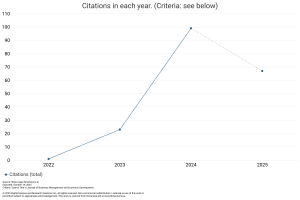Socio-Economic Network of Cattle Business in the Animal Market of Lili - Camplong, Kupang Regency
DOI:
https://doi.org/10.59653/jbmed.v1i02.145Keywords:
Socio–Economic Network, Cattle Business, Animal Market, Lili Camplong, Kupang RegencyAbstract
There are four fundamental goals for the people of East Nusa Tenggara in raising and developing cattle as a legacy from the Colonial. First, the cow is a sign of social status. The social status of the local community is not solely determined by how much money a family has, but more than that, social status is also determined by how many cows are kept in a large paddock. Secondly, the cow is an animal that supports the mating process. The cow is an animal that is a symbol of marriage for the people of NTT. Third, cows as animals that help the economy. Fourth, cattle are a commodity that is traded by local economic authorities who have extensive business networks. This descriptive qualitative research aims to examine the socio-economic networks among cattle farmers who come from the lower classes who also work as subsistence farmers, concerning cattle businessmen. As qualitative research, this study used three main methods to obtain field data. First, the in-depth interview was conducted with buyers, the local strong man Business Network, and the government of Kupang Regency. The second is the observation which was done in several villages in Kupang Regency and Camplong Market. Third, focus group discussion (FGD) was carried out on various related parties in the selling cycle involving local governments, businesses, cattle traders, and the community in general. The results of this study will be published in scientific journals and local media
Downloads
References
Corbetta, Piergiorgio. (2003). Social Research: Theories, Methods and Techniques. London: Sage Publication.
Databox Word Data. (February 2023). Pigs are the leading livestock in NTT in 2020. Retrieved from https://databoks.katadata.co.id/datapublish/2021/11/03/babi-jadi-ternak-unggulan-di-ntt-pada-2020.
Denzin, Norman K, and Yvonna S Lincoln. (2009). Handbook of Qualitative Research. Yogyakarta: Student Libraries.
Fajrianto, Ilham Dzikri and Suprehatin Suprehatin. (2020). Broiler Cattle Business Development Strategy for the Berkah Usaha Group in Blora. Agribusiness Forum. (Vol. 10, No. 1).
Hidayat, T., Madris, M., & Anwar, A. I. (2023). Influence of Population, Unemployment, and Poverty on Economic Growth in South Sulawesi Province. Pancasila International Journal of Applied Social Science, 1(01 SE-Articles), 68–79. https://doi.org/10.59653/pancasila.v1i01.134
Rurkinantia et al (2017). Cattle Slaughtering Business Development Strategy. Business and Management Applications. (Vol. 3, No. 3).
SMERU. (2000). Rural Credit in Kupang Regency, East Nusa Tenggara. (Special Reports). Social Monitoring and Early Response Unit (SMERU). Jakarta.
Wamaer, Demas and Andri, Kuntoro Boga. (2016). Overview of Beef Production and Consumption in the Special Autonomy Era in Papua Province. Journal of LPPM in the Field of Economy, Social, Culture, and Law (May Edition Vol. 3 No. 1).
Downloads
Published
How to Cite
Issue
Section
License
Copyright (c) 2023 Lasarus Jehamat, Yosef Emanuel Jelahut, Christine E. Meka, Marianus Saldanah Neno, Felisianus E. Jelahut

This work is licensed under a Creative Commons Attribution-ShareAlike 4.0 International License.
Authors who publish with this journal agree to the following terms:
- Authors retain copyright and grant the journal right of first publication with the work simultaneously licensed under a Creative Commons Attribution-ShareAlike that allows others to share the work with an acknowledgement of the work's authorship and initial publication in this journal.
- Authors are able to enter into separate, additional contractual arrangements for the non-exclusive distribution of the journal's published version of the work (e.g., post it to an institutional repository or publish it in a book), with an acknowledgement of its initial publication in this journal.
- Authors are permitted and encouraged to post their work online (e.g., in institutional repositories or on their website) prior to and during the submission process, as it can lead to productive exchanges, as well as earlier and greater citation of published work (See The Effect of Open Access).





























